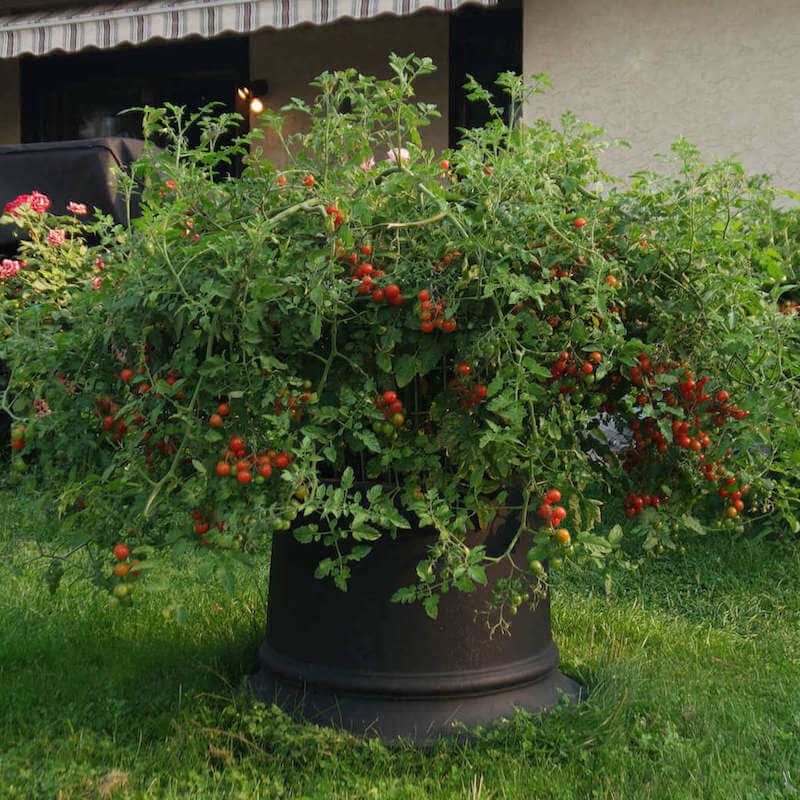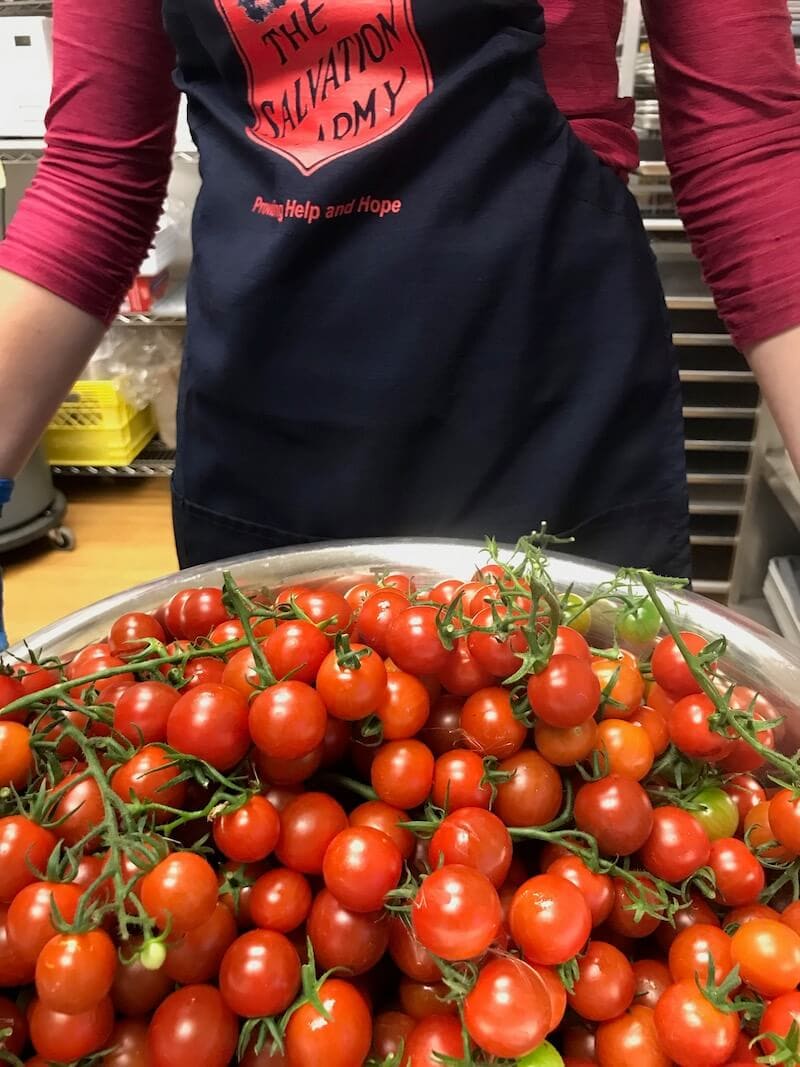
Tomatoes are grown commercially two ways, in parallel field rows and by greenhouse enclosed environment agriculture. Tomatoes growing in field rows are mechanically planted, fertilized, and harvested, most for the food processing industry. CEA tomatoes are grown for tabletop consumption and are typically shipped by truck to supermarkets. Global agribusiness produced 100 million tons of tomatoes in 2022 at a fraction of the price paid for hand harvested tomatoes. This has come at great expense to the environment, local farmers livelihoods, and people’s heath.
There are over 300,000 acres growing tomatoes in the United States and 3 million worldwide. These tilled fields are incredibly destructive to the environment: constant tilling destroys subterranean ecosystems beneficial to soil and plant, year after year applications of man-made fertilizers deadens the soil and pollutes the groundwater, exhaust from mechanized agriculture adds to global warming and climate change, inefficient irrigation wastes water, seed is typically genetically modified, and development of disease is common.
Commercial tomato producers use un-natural means to make fruit look good that in reality is tasteless and low in nutrient. When tomatoes are mechanically harvested, the whole plant gets picked including non-ripe and ripe tomatoes, which means more than a quarter of the harvest is discarded. Machine harvesting and sorting damage another quarter leaving only half the crop commercially viable - the other half is wasted.
Consumers are paying extra for vine ripened tomatoes at the supermarket. The name, vine ripened tomatoes suggest that they were ripened on a tomato plant naturally by the sun in the field where it was grown, when in fact they were ripened artificially. Want proof? Naturally ripened tomatoes never ripen red at the same time as they are displayed at the supermarket.
Tomatoes are artificially ripened using a process called ethylene gas treatment. Ethylene is a natural plant hormone produced by the ripening fruits of vegetables. By exposing tomatoes to ethylene gas, producers can accelerate the ripening process and bring them to market more quickly.
The process of ethylene gas treatment typically involves placing unripe tomatoes in a sealed room or container with a source of ethylene gas, such as a ripening agent. The ethylene gas triggers the ripening process by activating enzymes in the tomato that break down cell walls and convert starches to sugars.
TThe amount of ethylene gas and duration of treatment will depend on the time it takes for artificially ripened tomatoes to ship to the supermarket.
In situations where large warehouses of green tomatoes need to be ripened, other techniques such as temperature control or timed exposure to light is used in combination with ethylene gas treatment to speed up the process.
There are however, concerns about gas ripened tomatoes and their effect on human health and the environment. Ethylene gas treatments have been found to exhaust greenhouse gases into the atmosphere thereby contributing to climate change.

Greenhouse tomatoes grown in controlled agriculture environments are referred to as “hot house tomatoes". Even though field and CEA grow tomatoes differently, they share destructive elements that damage the environment including the burning and use of fossil fuels to run equipment and apply artificial fertilizer. Greenhouse tomatoes are also costly to produce, particularly if hydroponic systems are used to supply liquid and nutrient. Like their artificially grown cousins, hot house tomatoes look good, but have little taste and are nutrient deficient.
Lured by profit, farmers are often enticed to grow tomatoes off season in a controlled environment protected from the elements, however there are disadvantages that make growing tomatoes in a greenhouse a risky business.
While indoor tomato farming offers the advantages of year-round production and weather-related risk mitigation, it also carries substantial drawbacks, primarily financial. Costs have surged fourfold since the onset of the pandemic. Ongoing disturbances in the supply chains of necessary materials, coupled with the escalating prices of fossil fuels, have exerted considerable strain on farmers.
In the aftermath of the pandemic, broken supply chains and a move by governments to force a greener future has seen the cost of hydroponic fertilizer solutions skyrocket. Lack of availability and high prices have forced some operations to close and entirely stopped the industry from expanding. It's becoming evident that consumers will have to face higher prices for tomatoes, reduce their consumption, or forego them entirely. It would seem that growing tomatoes on small plots of land in or near where people live represents an opportunity of a lifetime to earn an excellent income and help people in need.
While hydroponic cultivation methods offer certain benefits, such as meticulous control over the growth environment and optimal use of water and nutrients, they also present some hurdles when it comes to tomato production. For instance:
It’s true that hydroponic systems can offer some benefits to the indoor farmers that grow them, there remains the risk of crop failure from disease and the threat of closure due to high operating costs.

Increasing production without sacrificing the look and taste of a tomato does not have to come at a price. A recent innovation in the production and propagation of tomatoes has been developed by Crop Circle Farms ® that give local farmers the ability to grow a bigger, better tasting tomato and turn a profit without damaging the environment.
Crop Circle Farms grow tomatoes in looping spirals rather than rows, which has many advantages: more tomatoes receive ripening sunlight as the sun tracks across the sky, an agricultural ground cover prevents weed growth and acts like a heat sink, limits evaporation, protects soil and builds subterranean ecosystems. Plants are fed nutrient intermittently through a proprietary water-smart irrigation system. Only the root of each plant is watered, and fertilized saving ninety percent of the water and ninety-five percent of the fertilizer used on a conventionally tilled acre. A till-don’t-drill method of open field plant propagation developed by Crop Circle Farms is used for growing tomatoes. Plants grow 20% faster so more ripened tomatoes are picked by season's end.
A Crop Circle Farm growing tomatoes is considered a “food-safe” agricultural production system - tomatoes are harvested clean and ready to eat. Spiraled plants build a strong unified root community that grows extremely robust, healthy plants that have a stronger defense against pests and disease. TAns so it would seem that tomatoes can be grown organically without the use of harmful chemicals. A Crop Circle Farm is ideal for urban farm operations that face land space issues where tractor pulled agriculture is not an option, but community labor is readily available.
A food-safe agricultural system ensures that the food produced is free from harmful contaminants and is safe for human consumption. Key components of a food-safe agricultural system include the adoption of GAP, a government guideline that established good agricultural practices to reduce the risk of contamination during the production, harvest, and post-harvest handling of crops.
Overall, a food-safe agricultural system for growing tomatoes involves a holistic approach to farming that prioritizes food safety at every step of the process, from production to consumption.
A quarter acre Crop Circle Farm growing tomatoes matches the tomato production of a one-acre cultivated row farm.

Once the ground has been leveled and prepared, a ground cover covers the entire area to prevent weed growth and provide a clean surface for vining, fruit ripening and harvesting. An irrigation line fastened in place between openings for plants forms a spiral. The spiral provides walk in access for planting and harvesting. Tomato plants are watered below the plant canopy to create a dry, draining growing environment mitigating threat of contamination. Watering below the plant canopy also prevents blossom end rot and development of other waterborne diseases. The ground cover is robust, able to survive the elements, and stays in place for 10 years or more before it requires replacement when the new ground cover is quarter turned to grow plants in virgin soil.
Tomato plants are left to overwinter within their ground cover openings to provide organic mulch for next year’s growth cycle. Overwintering plants also prevent early season weed growth as temperatures begin to rise several weeks before the last threat of frost. Last year’s plants are pulled from their openings and mulched in the spring before transplanting the new plants. A household electric drill with an auger attachment is used to “core” the soil from each opening to a depth of about 8 inches. The hole is filled with a mix of fertilizer and compost and planted with a new tomato plant.
Tomatoes plants grow over the ground cover without the need for support. Because of this, determinate tomatoes are the preferred cultivar, however any variety of indeterminate tomato can be grown as well providing the space between loops of the spiral is large enough. Keeping plants picked will keep them producing until frost.
Ready to transform your land into a high-yield, sustainable farm? Let Crop Circle Farms design and build a custom, low-impact, and water-efficient farm tailored to your needs. Double your income and cut your costs in half! Contact Us
Help us expand our mission to revolutionize agriculture globally. We are seeking partners to implement Crop Circle Farms to feed people in need. Together, we can build scalable food production systems that save water, reduce costs, and feed thousands of people. Contact Growing To Give